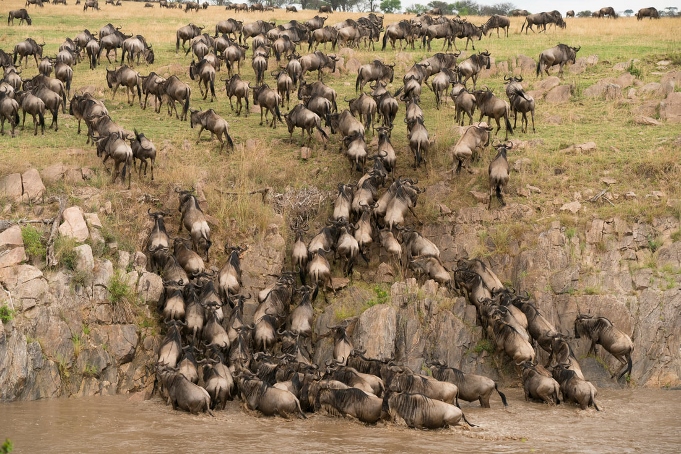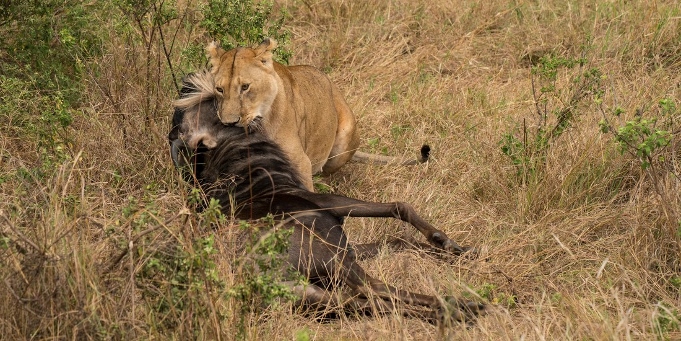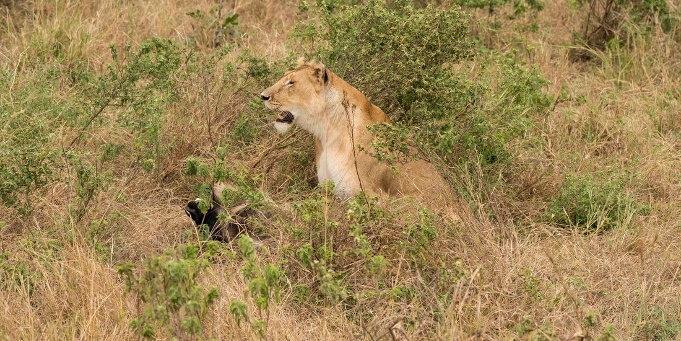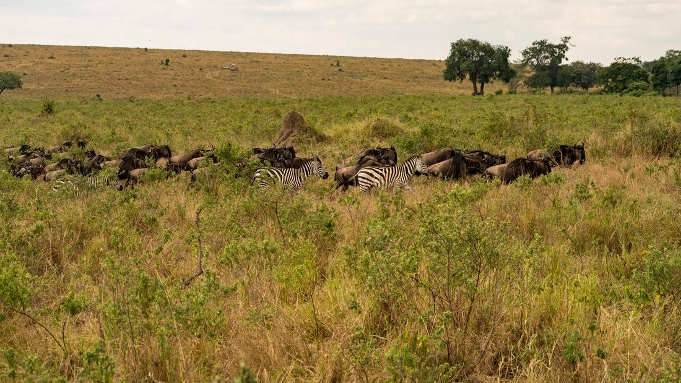Late in the Migration season vast herds are still crossing the river but there’s a predator on the loose! Clinton Richardson witnesses a spectacular hunt on the African plains …
* * * * * * * * * * * * * * * * * * * * * * * *
This series of blogs will take you on Clinton’s safari in Kenya as he travels from Atlanta (USA) to Nairobi National Park, Selenkay Conservancy (Amboseli), Ol Pejeta Conservancy (Laikipia) and Olare Motorogi Conservancy (Maasai Mara). Let’s join him on his journey as he shares his insights into the conservancies, Porini Camps and the people (and animals!) that he meets along the way. All images are from Clinton’s TrekPic.com photo site. Blog entries are from his Venture Moola blog at ReadJanus.com.
* * * * * * * * * * * * * * * * * * * * * * * *
No one ever called this beast a gnu while we were in Africa. Instead, it was called the wildebeest or blue wildebeest to be precise. But it is also known as a brindled gnu and gnu makes for a better title.
And, as you have guessed by now, we are spending much of this drive to take in the great wildebeest migration. The river crossing point we are aiming for is a good drive from the camp so we get see the wildebeest from several perspectives before we arrive for the dramatic conclusion.

As we drive across the plains our guides point out the herd of wildebeest in the far distance. They are barely specs on the horizon at this point but other wildlife seem alert to their presence nonetheless. First we spot lions, like the one above watching from the grass.

Then, further on and closer to the river crossing, we and the herd get closer. Here a pair of giraffe inspect the area for predators as the wildebeest make their way along.

Eventually we get close to and even inside a large herd of wildebeest with several zebra in their ranks. With the van stopped, we sit and watch. Soon, a group of wildebeest and a few zebra go sprinting down a hill in the direction of the river.

Everyone gathers together again, this time near a tree less than 100 yards from the river.

We have followed their progress and now sit, with a few other vehicles off to the side but between the wildebeest and the river. They wait and so do we.

Thoughts of television specials showing the great wildebeest migration with thousands of wildebeest madly racing across a river while crocodiles and other predators snap and grab at them crosses my mind. Is this what we will see?
We are near the end of the migration season for this area and the herd is not as big as my TV-spectacular-imagination has led me to expect. And being late, some of the predators like the crocodile may be satiated.
Still there is anticipation in the air. The wildebeest and their zebra companions are anxious as they wait. Then quickly, one and then another race toward the water followed by the group that had been waiting by the tree.
It is a race to the water and down the bank and into the river. They have picked a steep embankment on the other side. Our van has to race to the river bank too. We catch up with them as they plunge into the river.

No predators appear and most are quickly across.
Climbing the embankment is a challenge. One stumbles badly on the steep incline and falls. But the rest manage the river and climb without incident. We have seen a safe passage.

I confess to being somewhat disappointed. Not that I wished harm on any of the wildebeest but I was surprised there was not more drama.
We pulled our van back from the river bank and, with the other vehicles nearby, watched as more wildebeest gathered under the tree for their shot at a safe crossing.
And, that is when it happened. A flash of black followed quickly by a flash of light brown in front of us. Tall grass parting as they moved swiftly. A wildebeest had darted into the tall grass between the vehicles in a desperate attempt to evade a lioness..

The lioness quickly caught the wildebeest and a protracted struggle began. We watched as the two struggled.

The lioness grabbed the wildebeest by the throat and took it to the ground, with it kicking and fighting to get away the whole time.

Then she gripped the wildebeest’s throat harder and applied pressure. The wildebeest kicked its legs up and down.

The lioness kept her grip. After a few minutes the kicking stopped and the lioness dragged the carcass into the bushes.
She was winded from the struggle and sat their panting for a good while before giving off a roar. With her kill hidden, she left the area to inform her pride.

All while this was happening, behind us some of the wildebeest were starting to move. First a few, led by a zebra, and then more and, like before, suddenly all of them were racing to the river.

As before, our vehicle hurried back to the river bank to watch this second crossing.

As you can see, the bank on the other side of the river is not as steep as the last crossing. All made it across.
After this second pass, we headed back to camp. The joy and tragedy we found on the way back is the subject of next week’s entry.
First published 7 Mar 2019. All photos and text are © Clinton Richardson. All images are from his galleries at TrekPic.com
About Clinton Richardson
Clinton Richardson has been writing and taking photographs for decades. His books include the critically acclaimed 5th edition Richardson’s Growth Company Guide 5.0 and the award-winning book about social media and ancient coins called Ancient Selfies. His images, including images taken on his trip, can be viewed at TrekPic.com. His Venture Moola blog can be viewed at Readjanus.com.
See Other Blogs in this Series:
- Safari Countdown: Prepping for Kenya
- Safari 1: The Hunt
- Safari 2: Off to Nairobi
- Safari 3: Tented Camps & Conservancies
- Safari 4: Passports in His Underpants
- Safari 5: Night Lions to Amboseli
- Safari 6: Amboseli to Selenkay
- Safari 7: Pooh on You
- Safari 8: Eaten by a Lion?
- Safari 9: The Maasai
- Safari 10: On the Move
- Safari 11: Crash on the Grass
- Safari 12: Sundowner Surprise
- Safari 13: Stalag Panzee
- Safari 14: Bump in the Night
- Safari 15: Dry Season Showers
- Safari 16: How Many Wives Would You Like to Have?
- Safari 17: Distracting His Highness
- Safari 18: How to Eat a Tree
- Safari 19: Hunting with Children
- Safari 20: Blue Jean Symphony
- Safari 21: African Nights
- Safari 22: Dinosaurs on the Wing

